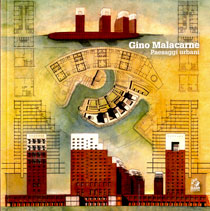
The Architecture of Gino Malacarne.
Two exhibitions and two books
If drawing be the language of architecture, then Gino
Malacarne’s architecture is unquestionably eloquent. The coloured
perspectives, the axonometric projections and the models all give an
account of an architecture in which figural expression has the last
word on the typological system: his works of architecture all have a
façade, a front that is quite distinct from what lies behind it,
and through which they relate to the world (the “rediscovered
works” risk their all and congregate on the urban scene, upheld
by a mellow courage).
Thus, if on the one hand the technical ability surfaces, that knowhow
which organically unites the imprint of the type with the appearance of
a language, on the other this constructive and decorative energy
manages to bring to life the allure of a particular feeling.
The type of atmosphere changed with time, circumstances, and perhaps
also the designer’s mood in this long series of works ranging
from 1983 to 2021. My personal favourites are: the “Project for
24 social housing units in Spinea” (1987), thanks to that
courtyard surrounded by balconies-loges from which it is easy to
imagine the most disparate humanity gazing out expectantly or attending
an event that we would all like to be a party; the “Project for
the Werfthafen of Duisburg” (1991), where those four good men and
true stand, well aligned along the taut arch of a plinth, on a narrow
sliver of land right on the edge of the city. In Gino’s nocturnal
drawings, the tiered towers become guardians and the lady opens the
window amazed by the glow of a twilight – or is it the first
light of dawn? The third is the “Project for Punta Perotti in
Bari” (2006), where the atmosphere is utterly exotic. We could
talk about the methodical composition with which the spaces of the
courts follow one another, but what really prevails is the charm of an
atmosphere that reminds us of the coasts of the Mediterranean and
beyond, along the merchant road of an ancient oriental city from whose
flat horizon the dome of some sacred work of architecture suddenly
arises.
Major urban projects such as the “Project for Berlin
Königsstadt” (1995), the “Urban Redevelopment Project
for the Artisan Village and Madonnina District in Modena” (2005),
the “Project for Piazzale Stanga and Via Venezia in Padua”
(2014) or the Project for the Port of Bari (2021) each deserve a
chapter to themselves. For all of these, the assumption of a realism
counts so that it becomes unrealistic to think of being able to rebuild
entire parts of the city in question. The contradictions and formal
aporias of the contemporary city are addressed in fragments,
insufflating into the urban organism those works of architecture
capable of reactivating internal relations and making the cityscape
recognizable by establishing a hierarchy between the parts. These are
figures whose operation takes place by proximity (as in the completion
of large urban blocks) or “at a distance” (on the basis of
the topological interrelations which the towers are able to weave with
other monumental urban facts). In this way, in a happy synopsis, the
continuity and organicity of the urban space are reconstructed, where
the voids between the parts, the pieces, the fragments, or more simply,
the works of architecture, are only necessary to restore to the Italian
and European city that formal and expressive quality, so that –
as Johann Herder claimed – citizenship can continue to be the
very language of one’s own city.
The projects we have talked about and many more, the delightful
colourful drawings, models, and architectural sketches by Gino
Malacarne have been the subject of two exhibitions, one, conceived and
promoted by the cultural association Di Architettura together with the
Municipality of Padua, was held at the Palazzo della Gran Guardia
between 17 and 30 September 2022, the other, entitled “Gino
Malacarne. Paesaggi Urbani”, in the Ambulatory of the Library of
Palazzo Gravina in Naples between 13 February and 5 March 2023.
Both were supplemented by a catalogue.
Lamberto Amistadi
Book card 1
Edited by: Francesco Lucchi, Cinzia Simioni, Alessandro Tognon
Title: Gino Malacarne. Architetture
Language: Italian
Publisher: Il Poligrafo
Characteristics: dimensions 21x21 cm, 112 pages, paperback, color
ISBN: 978-88-9387-223-2
Year: 2022
Book card 2
Edited by: Renato Capozzi, Camillo Orfeo, Federica Visconti
Title: Gino Malacarne. Paesaggi urbani
Language: Italian
Publisher: Clean edizioni
Characteristics: dimensions 17x17 cm, 104 pages, paperback, color
ISBN: 978-88-8497-863-9
Year: 2023